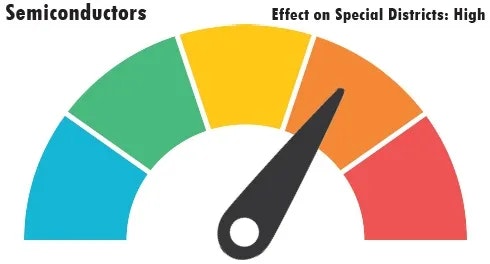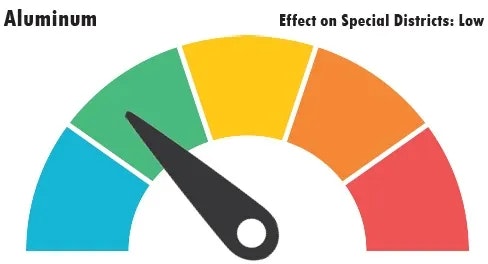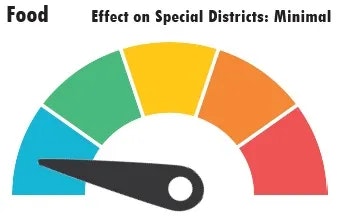The Changing Supply Chain

July 22, 2022 | Alex Terlecky
What Public Entities Can Expect From the Disruption
Public entities in Colorado are feeling the pressure of the supply chain crisis coupled with sky-high inflation. Budgets are already tight, and these factors aren’t making things any easier.
According to the March 2022 Economic & Revenue Forecast from the Colorado Legislative Counsel, inflationary pressures have gained “significant momentum from wage gains, pandemic-induced supply chain disruptions, and geopolitical conflict.”
For example, the report predicts that for the Denver-Aurora-Lakewood area, the consumer price index—the average change overtime in price for a market basket of consumer goods—will rise 7% in 2022 and 3.8% in 2023. Potential risks surround this forecast, which could be exacerbated by additional supply chain disruptions, either caused by the pandemic or the war in Ukraine.
In addition, Colorado’s inflation rate exceeded the national rate in January 2022. Although Colorado’s economy continues to show growth across most sectors as the pandemic approaches an endemic phase, the war in Ukraine has caused inflationary pressures to spike further by impacting oil, agriculture, and metals markets.
The reason prices are rising has to do with the dynamics of supply and demand. Due to an increase in e-commerce activity to unprecedented levels, demand for products have increased beyond the market’s ability to produce or ship what is ordered. The result is scarce inventory and higher freight costs, which is passed along to consumers via higher price tags.
One of the biggest challenges to the supply chain is the global logistics disruptions. These disruptions will slow business growth in 2022 and remain the major contributor to the current inflation. Bottlenecks have occurred in Asia, there’s a major shortage of drivers, and container ships are stuck in ports, waiting for the goods aboard to be unloaded. Although an increase in operating hours has been implemented to solve these logistical issues, a lack of workers means that efficiency is still low. Unfortunately, economists are expecting these challenges to continue through 2022 and may extend into 2023.
What does this mean for Colorado?
For a landlocked state, Colorado is particularly susceptible to supply chain shortages. There are a few supply constraints that will prove to be the biggest challenge for consumers to acquire.

Demand for semiconductors is at unprecedented levels. Semiconductors are material products that have an electrical conductivity value between a conductor and an insulator, and they are used extensively in electronic circuits.
This includes everything from computers to automobiles and household appliances.
According to Deloitte’s 2022 semiconductor industry outlook, the chip shortages over the last two years have resulted in revenue misses of $500 billion in the semiconductor and related customer industries. Lost auto sales accounted for $210 billion in 2021 alone. Although semiconductor producers have increased production, this isn’t expected to meet demand in 2022.
Semiconductors are most commonly found in:
- Televisions
- Personal computers
- Mobile phones
- Automobiles
- Advanced medical care devices
For health and hospital districts, as well as EMTs and fire departments that use medical care devices like blood pressure monitors, ECGs, MRI machines, chemistry/blood gas analyzers, and other wireless monitors, taking account of current stock and keeping up with routine maintenance where applicable is key.
The same goes for special districts that rely on vehicles for their operations. Both new and used automobiles are in short supply, and both are highly affected by inflation. For assistance monitoring and maintaining your apparatuses, the CSD Pool offers discounted rates for Vector Check It.

Shortages in aluminum have produced major impacts within the construction industry and beverage industry. These shortages are due in part to China’s decrease in production to curtail carbon emissions and Europe’s decrease in production due to the high price of natural gas utilized in production.
According to European Aluminum’s letter to the EU, the continent lost over 650,000 tons of annual production capacity in the last quarter of 2021 alone.
Although there are alternative efforts advancing in the production of new aluminum plants, at least domestically, the demand for 2022 is expected to outpace supply.
Aluminum is most commonly found in:
- Car parts
- Cans and packaging
- Electronics
- Household items such as utensils, refrigerators, pots, and pans
- Furniture
- Construction-related items such as window and door frames, railings, shelves, and roofs and walls
If you’re a special district looking to make building upgrades, such as for new, energy efficient windows and doors, or begin a new construction, expect significant delays and increases in price. There may be a benefit in waiting, if possible, to 2023 to benefit from a potential increase in supply.
At the same time, it is important to expect delays or issues with repairs if your district encounters any storm damage this season. Have a backup plan in place if you are stuck waiting on materials to repair roofs or vehicles affected by hail, tornadoes, or flooding.
Beyond that, if ergonomic equipment is on your radar for staff, you may encounter supply issues as well. Be sure to consult with the CSD Pool’s Safety Consultant on an ergonomic assessment, free for members, to discuss alternative options that may not suffer from the same supply shortages. For a free assessment, email safety@csdpool.org.

Shelves at grocery stores appear to be a little emptier than normal as 2022 continues.
Labor constraints and operational setbacks at farms looks to keep supply limited through 2022 for certain items. The rise in sick workers caused by the Omicron variant also disrupted productivity at food manufacturing plants.
In addition, shortages of fertilizer and pesticides have impacted yields, and this shortage is poised to extend into 2023 due to the climbing national gas prices in Europe and curbing exports out of Russia and China.
However, the USDA reports that there is no nationwide shortage of food, and that inventory shortages may be caused by stores inability to restock in a timely manner. In some cases, as is the case with liquor, the issue is not in the production of the beverage; rather, it is in production of the bottle and cork to contain it.
Stores in 2022 are having difficulty stocking:
- Avocados
- Paper goods
- Canned goods
- Eggs and meat
- Liquor
For special districts, the effects of this shortage are minimal. Unless you are planning a much-needed employee appreciation event, food shortages won’t be affecting your bottom line severely.

Plastic resin, which is the raw material used to make plastic packaging as well as paint, has been in short supply for nearly a year.
In addition, delivery times have shown to be longer than they were prior to the pandemic. New orders remain strong, but shipments are delayed by production problems and workforce shortages.
Manufacturers have begun stockpiling the product, which will help supply constraints this year. But ocean freight reliability is below 40%, a number that indicates suppliers are confirming shipments to customers, only to have the customers find out those shipments never left the port of origin.
Two of the most widely produced plastic resins are polyethylene and polypropylene, both of which are affected by the supply chain shortage . These are found in the following products:
- Electrical insulation
- Medical equipment
- Laminates
- Automobile bumpers
- Packaging
- Water bottles
While not a major issue for special districts, the effect will be seen when purchasing PPE, medical equipment, or other items which contain these resins.
To help offset the costs, be sure to use our Safety and Loss Prevention Grant program. If it can be demonstrated to improve your district’s safety or loss prevention, we’ll cover 50% of the costs.

A high cost of material and issues meeting demand have plagued construction projects throughout 2021 and so far into 2022. Overall construction input prices are up 22.3% compared with a year ago, according to the National Association of Homebuilders.
This has been due to issues acquiring everything from drywall to lumber, the latter of which has seen prices triple in the last six months . On top of that, labor shortages and the booming housing market have also complicated the equation.
The biggest shortages throughout the past year have been with:
- Lumber
- Steel
- Electrical supplies
- Copper wire
- Lighting supplies
These items may not have a direct effect on special districts, but they can cause the delay of a new project from being completed.
When Will These Issues End?
As of now, there is no end in sight to the supply chain issues, which have only been exacerbated in 2022 by the ongoing war in Ukraine. Although a low unemployment rate has aided with production, there is still uncertainty involved with the pandemic, which could lead to intermittent staff shortages that were seen with Omicron in January.
For now, special districts should expect the unexpected and plan for shortages and delay when it comes to ordering items that relate to the categories above.
As always, be sure to take advantage of your member discounts and CSD Pool grant programs to help with the costs. More information can be found at csdpool.org/discounts and csdpool.org/grants.
